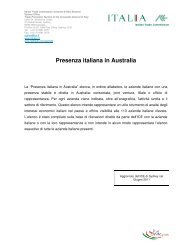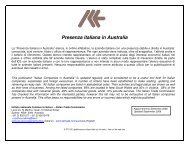Price Determination in the Australian Food Industry A Report
Price Determination in the Australian Food Industry A Report
Price Determination in the Australian Food Industry A Report
You also want an ePaper? Increase the reach of your titles
YUMPU automatically turns print PDFs into web optimized ePapers that Google loves.
<strong>Price</strong>s through <strong>the</strong> cha<strong>in</strong><br />
Our analysis of <strong>the</strong> history <strong>in</strong> farmgate and retail supermarket pric<strong>in</strong>g over <strong>the</strong> past six years is set<br />
out below, illustrat<strong>in</strong>g pric<strong>in</strong>g through <strong>the</strong> cha<strong>in</strong> for a 2 litre whole milk product. The major trigger<br />
for change of <strong>the</strong> share of marg<strong>in</strong>s was <strong>the</strong> pric<strong>in</strong>g of national contracts for <strong>the</strong> packag<strong>in</strong>g of<br />
private labels. In view of surplus capacity, processors bid for <strong>the</strong> rights to supply those contracts<br />
at low prices <strong>in</strong> order to optimise plant throughput. This has resulted <strong>in</strong> a cut <strong>in</strong> wholesale prices<br />
for <strong>the</strong> private label by more than 25c a litre from pre-exist<strong>in</strong>g regulated prices.<br />
Figure 13. Supermarket sales, packaged milk, 2 litre, % of retail sales value<br />
%<br />
100<br />
90<br />
80<br />
70<br />
60<br />
50<br />
40<br />
30<br />
20<br />
10<br />
0<br />
1997 2000 2003<br />
retailer<br />
levy<br />
processor<br />
farm<br />
Source: Dairy Australia<br />
The above analysis is an assessment of an <strong>in</strong>dustry-wide average. Differences exist <strong>in</strong> farmgate<br />
prices depend<strong>in</strong>g on <strong>the</strong> supply region and, at wholesale level, depend<strong>in</strong>g on <strong>the</strong> bus<strong>in</strong>ess mix.<br />
Processor costs <strong>in</strong>clude meet<strong>in</strong>g costs of cartage, process<strong>in</strong>g and distribution. Market<strong>in</strong>g costs<br />
have tended to <strong>in</strong>crease as processors attempt to put greater efforts <strong>in</strong>to support of brands<br />
through <strong>the</strong> route trade. In recent years certa<strong>in</strong> companies have achieved significant<br />
improvements <strong>in</strong> process<strong>in</strong>g costs through <strong>in</strong>vestment and bus<strong>in</strong>ess rationalisation. S<strong>in</strong>ce <strong>the</strong><br />
major shift <strong>in</strong> product marg<strong>in</strong>s <strong>in</strong> 2000, processors have won back small ga<strong>in</strong>s <strong>in</strong> net wholesale<br />
prices, though <strong>the</strong> average <strong>in</strong>crease <strong>in</strong> wholesale returns is restricted by <strong>the</strong> <strong>in</strong>creas<strong>in</strong>g market<br />
share of <strong>the</strong> private labels.<br />
<strong>Price</strong> <strong>Determ<strong>in</strong>ation</strong> <strong>in</strong> <strong>the</strong> <strong>Australian</strong> <strong>Food</strong> <strong>Industry</strong> A <strong>Report</strong><br />
DAIRY – NATURAL CHEDDAR CHEESE<br />
Overview of <strong>the</strong> product group<br />
Cheddar cheese is a key product l<strong>in</strong>e to <strong>the</strong> <strong>Australian</strong> domestic dairy sector. Cheese products use<br />
45 per cent of milk consumed <strong>in</strong> manufactured dairy products or approximately 36 per cent of total<br />
milk usage, mak<strong>in</strong>g it <strong>the</strong> largest product category for <strong>the</strong> dairy <strong>in</strong>dustry. There are up to 50 style<br />
categories <strong>in</strong> <strong>the</strong> cheese cab<strong>in</strong>et of <strong>the</strong> retail market, differentiated on <strong>the</strong> basis of production<br />
method, fat content, texture and appearance. Cheddar is <strong>the</strong> largest style category with<strong>in</strong> <strong>the</strong><br />
cheese products group with about 55 per cent of total output. Australia exports about <strong>the</strong> same<br />
total volume of cheese that it consumes <strong>in</strong> domestic markets.<br />
About 55 per cent of domestic cheese sales are made through <strong>the</strong> supermarket channel. Of that<br />
segment of <strong>the</strong> retail market, <strong>the</strong> product mix (Figure 14) shows <strong>the</strong> importance of <strong>the</strong> 500g and<br />
1kg matured cheese l<strong>in</strong>es, provid<strong>in</strong>g almost half of all cheddar sales. Processed cheddar, <strong>in</strong>clud<strong>in</strong>g<br />
slices provides 28 per cent of sales.<br />
24







